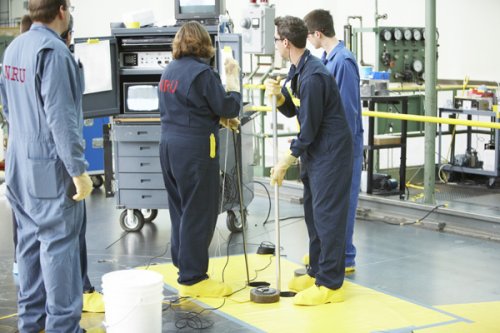
Inside the NRU. (Courtesy: Atomic Energy of Canada)
By Hamish Johnston at the CAP Congress in Edmonton
In 1957 Atomic Energy of Canada built “a reactor that can do everything” at Chalk River, Ontario. Dubbed the National Reactor Universal – or NRU – that facility will shut down for good in 2018 and Canada’s neutron-science community is now pondering its future.
In the short term, physicists will have to travel abroad to use neutron sources, such as those at Oak Ridge in the US and Grenoble in France. The challenge during this 10–15 year period will be to keep the research community together and make sure that vital skills and expertise built up over decades at the NRU will be retained. In the longer term, there are calls for Canada to build a new neutron facility, but it is by no means clear whether that will happen.
Yesterday at the CAP Congress in Edmonton, John Root and Chris Wiebe led a discussion about the future of neutron science in Canada. Root has spent much of his career at the NRU so the shutdown has a very personal dimension for him. Wiebe is at the University of Winnipeg and uses neutrons to study materials.
“We have to have neutrons” was one response from the floor that seemed to sum up the mood at the session. There was also some discussion about building a new neutron facility as a university consortium along the lines of TRIUMF in Vancouver, which has been very successful.
After the session I sat down with Root and Wiebe to ask them why the NRU is so special. The answer is versatility. As research reactors go, it is very large, and that means that its core can be poked and prodded with test materials while it happily keeps delivering neutrons to its beamlines.
The NRU gave Bertram Brockhouse the neutron beams that won him a Nobel prize for his pioneering work on phonons. It was also used to simulate the conditions present in nuclear accidents such as that at Three Mile Island. Neutrons from the NRU provided key insights into the “Haldane gap” in magnetic materials and also the biophysics of living membranes. Its scientists also pioneered the use of neutrons to measure the stress on the components of engines while they are running. And, perhaps most importantly, the NRU continues to play an important role in the diagnoses and treatment of diseases such as cancer by churning out a large proportion of the various medical isotopes used throughout the world.
The NRU will have served Canada for more than 60 years when it finally shuts down. Now, the challenge for the Canadian neutron community is to sustain the expertise built-up over those decades and ensure that a facility of equivalent merit is created for future generations of scientists.
Over the years, Chalk River contributed immensely to the reactor technology based on natural uranium plus heavy water as moderator, and the use of the reactor-based neutrons for research in material sciences along with the industrial production of tritium and the different isotopes for medecine. Since, some years, the reactors are being replaced by the powerful pulsed accelerator-based spallation as neutron source and the medical isotopes are being produced via the appropriate accelerators.
Powerful pulsed neutron sources have indeed been built or are under construction around the world. But reactors are also still being built. They are competitive neutron sources. The main point is starting March 2018, Canada will have neither. There will be no domestic medium or high flux neutron source.
Medical isotopes, and in particular Mo-99, production by accelerators is an emerging supply chain and not yet proven to be able to meet demand. Some will argue, the demand is now lower than 6 years ago. You have to ask yourself, is use being adjusted to available supply, or is supply meeting demand? When it comes to life-saving technologies, I would hope supply meets demand.
Trackback: » Closing Canada’s ‘universal’ reactor